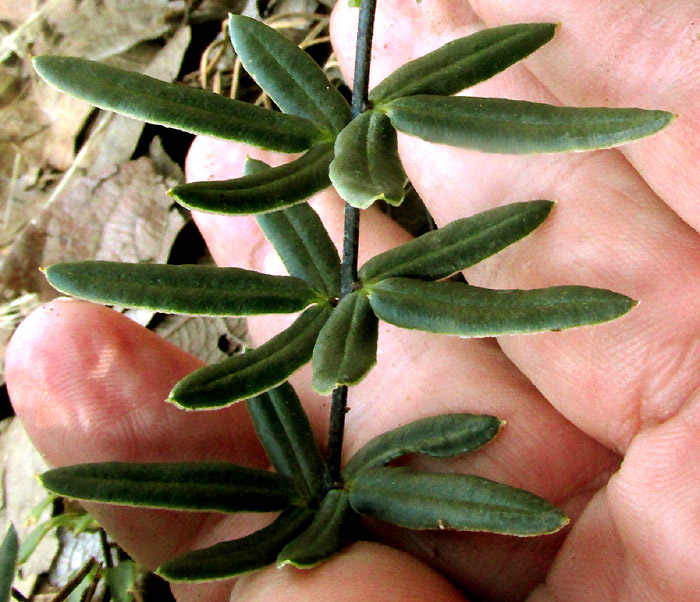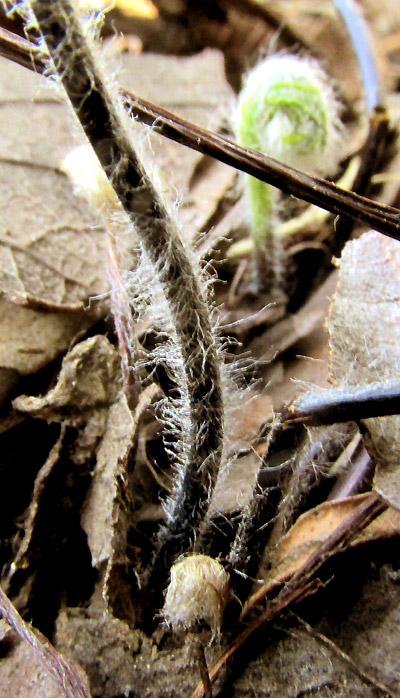Excerpts from Jim Conrad's
Naturalist Newsletter
Entry dated November 9, 2023, from notes taken near Cascadas de La Piedad waterfall 3kms NW of the community of San Pablo, municipality of Almeaco de Bonfil; beside canyon of La Piedad; N20.1017°, W100.0041°, elevation 2360 meters (7750ft); extreme southern Querétaro state, MÉXICO
PELLAEA VILLOSA

On a steep slope near the canyon's rim, the above cliffbrake fern caught my attention because the lower pinnae are divided into three pinnules, while the upper ten or so pairs of pinnae are simple, or undivided. Here's some lower, three-divided, or ternate, pinnae:

Her's a close-up of part of a lower pinna's point of attachment with its rachis:

In our area, the row of tiny, black sporangia peeking from inside turned-under pinnule margins, the false indusia suggest either a cliffbrake, genus Pellaea, or a lipfern, genus Hemionitis. The boundaries between these two fern groups, as well as the boundaries with other genera, are much in question. Since our fern's fronds were largely once-divided with curled-under pinnule margins not toothed, lobed or crenulated, and since this was a rocky area on a cliff, to me it looked more like a cliffbrake -- for the time being. For later identification to species level, it was important to note that the fern's black rachis was conspicuously covered with long hairs.
Genetic studies indicate that the situation is much more complex than imagined in the old days. The most recent study I can find on the matter dealing with Mexican species is the 2007 genetic study by Eric Schuettpelz and others entitled "A molecular phylogeny of the fern family Pteridaceae: Assessing overall relationships and the affinities of previously unsampled genera." In that work "rampant polyphyly" was found among genera known as cheilanthoid ferns, which includes cliffbrakes and lipferns. "Polyphyly" in this case refers to genera with species apparently needing to be assigned to other genera, but aren't, sometimes because no other appropriate genus exists.

According to the 2019 treatment of the fern family Pteridaceae appearing in the Flora del Bajío, which considers Querétaro state, if you have a cliffbrake whose rachises are black and covered with conspicuous hairs -- like those seen above and at the right on a frond's stipe -- and if more than four of the frond's upper pinnae are simple, not divided into three parts, then you have PELLAEA VILLOSA, with no commonly used English name.
But there's this: The current online Flora of North America treatment regards our hairy-stemmed fern as a mere subspecies of a similar, more widely and commonly occurring taxon, so that our fern should be called Pellaea ternifolia subsp. villosa. The Flora also reports that the typical Pellaea ternifolia is diploid (possessing the normal two sets of chromosomes) while the villosa subspecies is tetraloid (with four sets of chromosomes). The authors further write that studies suggest that our hairy-stalked cliffbrake arose as a hybrid between the typical Pellaea ternifolia, and a yet unidentified diploid species.
Beyond that, Kew's Plants of the World Online database currently assigns the name Pellaea villosa to "unplaced" status, meaning that the name is unacceptable, but our hairy-stemmed fern isn't known by any other acceptable name. Thus the name Pellaea ternifolia subsp. villosa in not to be used.
Despite all this human uncertainty, just look at the beauty and dignity our fern still displays, even issuing fresh new fiddleheads into the upcoming season.
Our fern more or less known as Pellaea villosa has been collected once in the US, in the Davis Mountains of southern Texas, but otherwise occurs sporadically only in Mexico's uplands, south to Oaxaca.